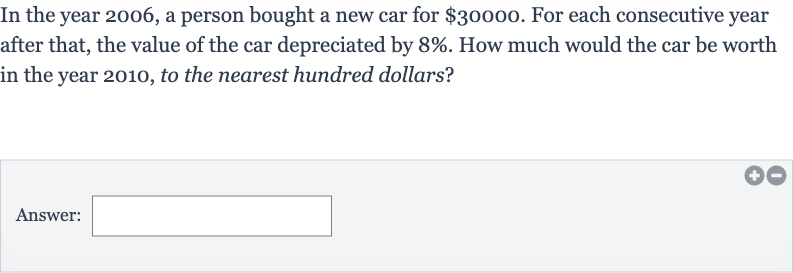Full solution
Q. In the year , a person bought a new car for . For each consecutive year after that, the value of the car depreciated by . How much would the car be worth in the year , to the nearest hundred dollars?Answer:
- Determine initial value and rate: Determine the initial value of the car and the annual depreciation rate.The initial value of the car, , is . The annual depreciation rate, , is .
- Convert rate to decimal: Convert the annual depreciation rate from a percentage to a decimal.To convert to a decimal, divide by : .
- Calculate years of depreciation: Calculate the number of years, , the car has depreciated from to . The number of years is years.
- Use exponential decay formula: Use the formula for exponential decay to find the value of the car after years.The formula is , where is the final value.
- Substitute values and calculate: Substitute the known values into the formula and calculate the value of the car in .
- Calculate : Calculate the value of
- Multiply initial value by factor: Multiply the initial value of the car by the depreciation factor to find the final value.
- Round final value: Round the final value to the nearest hundred dollars as requested.The car would be worth approximately in the year .
More problems from Exponential growth and decay: word problems
QuestionGet tutor help
QuestionGet tutor help
QuestionGet tutor help
QuestionGet tutor help
QuestionGet tutor help
QuestionGet tutor help
QuestionGet tutor help
QuestionGet tutor help
QuestionGet tutor help

